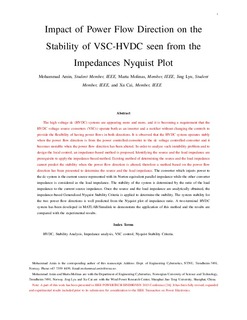| dc.contributor.author | Amin, Mohammad | |
| dc.contributor.author | Molinas Cabrera, Maria Marta | |
| dc.contributor.author | Lyu, Jing | |
| dc.contributor.author | Cai, Xu | |
| dc.date.accessioned | 2018-01-22T12:49:19Z | |
| dc.date.available | 2018-01-22T12:49:19Z | |
| dc.date.created | 2018-01-19T23:37:08Z | |
| dc.date.issued | 2017 | |
| dc.identifier.issn | 0885-8993 | |
| dc.identifier.uri | http://hdl.handle.net/11250/2478733 | |
| dc.description.abstract | The high-voltage dc (HVDC) systems are appearing more and more, and it is becoming a requirement that the HVDC voltage-source converters (VSCs) operate both as an inverter and a rectifier without changing the controls to provide the flexibility of having power flows in both directions. It is observed that the HVDC system operates stably when the power flow direction is from the power-controlled converter to the dc-voltage-controlled converter, and it becomes unstable when the power flow direction has been altered. In order to analyze such an instability problem and to design the local control, an impedance-based method is proposed. Identifying the source and the load impedance are prerequisite to apply the impedance-based method. The existing method of determining the source and the load impedance cannot predict the stability when the power flow direction is altered; therefore, a method based on the power flow direction has been presented to determine the source and the load impedance. The converter that injects power to the dc system is the current source represented with its Norton equivalent parallel impedance, while the other converter impedance is considered as the load impedance. The stability of the system is determined by the ratio of the load impedance to the current-source impedance. Once the source and the load impedance are analytically obtained, the impedance-based Generalized Nyquist stability criterion is applied to determine the stability. The system stability for the two power flow directions is well predicted from the Nyquist plot of impedance ratio. A two-terminal HVDC system has been developed in MATLAB/Simulink to demonstrate the application of this method, and the results are compared with the experimental results. | nb_NO |
| dc.language.iso | eng | nb_NO |
| dc.publisher | Institute of Electrical and Electronics Engineers (IEEE) | nb_NO |
| dc.title | Impact of power flow direction on the stability of VSC-HVDC seen from the impedance nyquist plot | nb_NO |
| dc.type | Journal article | nb_NO |
| dc.description.version | submittedVersion | nb_NO |
| dc.source.volume | 32 | nb_NO |
| dc.source.journal | IEEE transactions on power electronics | nb_NO |
| dc.source.issue | 10 | nb_NO |
| dc.identifier.doi | 10.1109/TPEL.2016.2608278 | |
| dc.identifier.cristin | 1548008 | |
| dc.description.localcode | © 2016 IEEE. Personal use of this material is permitted. Permission from IEEE must be obtained for all other uses, in any current or future media, including reprinting/republishing this material for advertising or promotional purposes, creating new collective works, for resale or redistribution to servers or lists, or reuse of any copyrighted component of this work in other works. | nb_NO |
| cristin.unitcode | 194,63,25,0 | |
| cristin.unitname | Institutt for teknisk kybernetikk | |
| cristin.ispublished | true | |
| cristin.fulltext | preprint | |
| cristin.qualitycode | 2 | |
